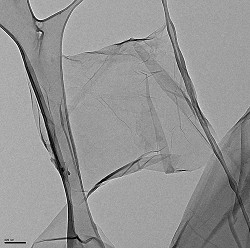Graphene-based nanocomposites for 3D-printed electronic devices
Rapid prototyping is well-known for its convenience and cost-effectiveness. With a 3D printer, businesses can reduce the design-to-product timing, saving significant amounts of money in the process. But whilst the technique itself is well-oiled, materials still present room for improvement. “Currently, 3D printing technology can be classified depending on the material used for printing prototypes. Thermoplastics like ABS or PLA are amongst the most used materials: They can easily be moulded, are very cost-effective, and the former property makes them the material of choice for additive manufacturing,” says Dr Maria Soria, Researcher in solid state chemistry at the Institute of Material Science of Barcelona (ICMAB). But easy moulding is not only a quality. In fact, it can quickly become a disadvantage, since the material’s resistance depends on a temperature gradient (a physical quantity that describes in which direction and at what rate the temperature changes the most rapidly around a particular location): Thermoplastics quickly become unusable when printing prototypes that require special thermal resistance. Furthermore, they have no conductivity, which also limits their use. With this in mind, it seems only natural that researchers would look for new materials with better structural and conductive properties. Graphene, with its high conductivity, its mechanical strength and its hierarchical pore structures and porous channels, is an ideal candidate. “The idea would be to use graphene or its derivate whilst maintaining the associated advantages of thermoplastics, such as the ability to be moulded. We believe that using graphene-enhanced nanocomposite materials in 3D printing could have a disruptive impact on the market,” Dr Soria explains. Thanks to funding under the 3D-PRINTGRAPH (Graphene reinforce composites for 3D printing technology) project, Dr Soria has embarked on a two-year venture to ‘merge’ layered graphene with the lowest melting point polymers for use in future 3D-printing. If successful, the project could open the door to the fabrication of electronic devices like batteries, sensors and radiofrequency antennas. “We’ve already carried out the synthesis and characterisation of PLA, ABS, PCL and PCL-Diol composites with graphene, which first required graphene synthesis. We used graphite as a precursor and, by means of its oxidation and subsequent chemical reduction, we obtained a Reduced graphene oxide (RGO) with similar properties to graphene. From there on, we synthesised the composites with a load of 4 % in graphene, obtaining materials with apparent homogeneity in all cases,” Dr Soria explains. Although the project won’t be completed until the end of August, the new composites already present better mechanical strength and thermal resistance than polymers without graphene loading. But 4 % graphene – the maximum amount that allows for maintaining suitable viscoelasticity and adhesion in the end material – is not enough to provide conductivity, the researchers found. “We now have to explore new ways to homogenise the polymer-graphene mixture, or even to increase the amount of graphene in the mixture to ensure there is contact between the graphene layers and to facilitate the conductivity,” says Dr Soria. Besides this work, which is central to the project, Dr Soria and her team have been developing nanocomposites based on photo curable polymers and graphene, to ensure that the milestones of the project can be maintained and to improve the general effectiveness in the research. As she points out, this adds to the groundbreaking nature the project. Should everything go according to plan, the consortium plans to partner with Hewlett-Packard in Barcelona to test the developed graphene nanocomposites on their 3D printers.
Keywords
3D-PRINTGRAPH, nanocomposites, 3D printing, graphene, conductive, composites



